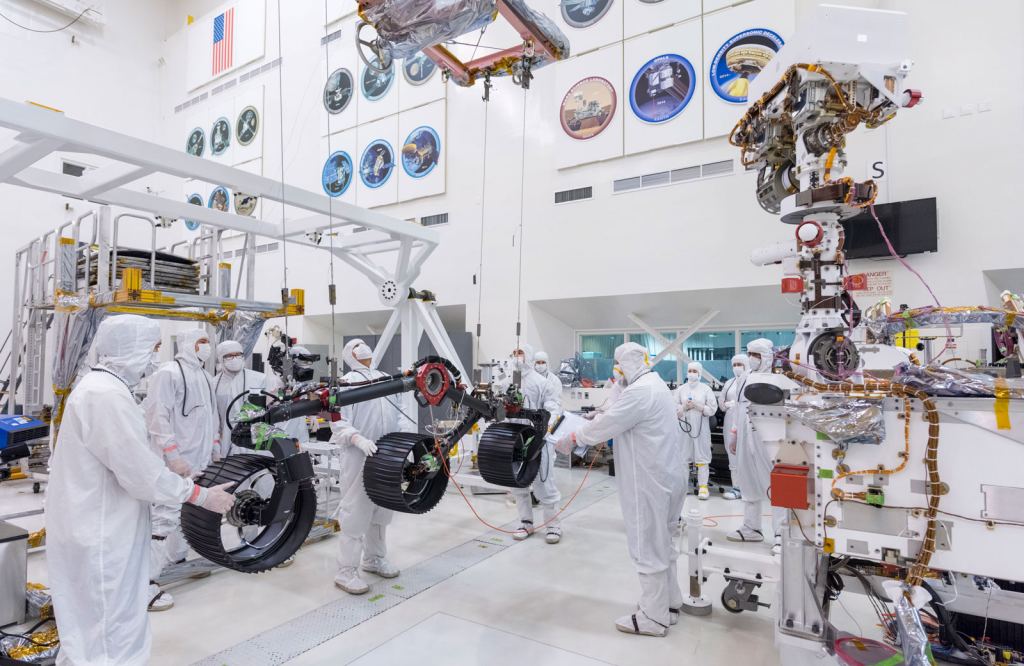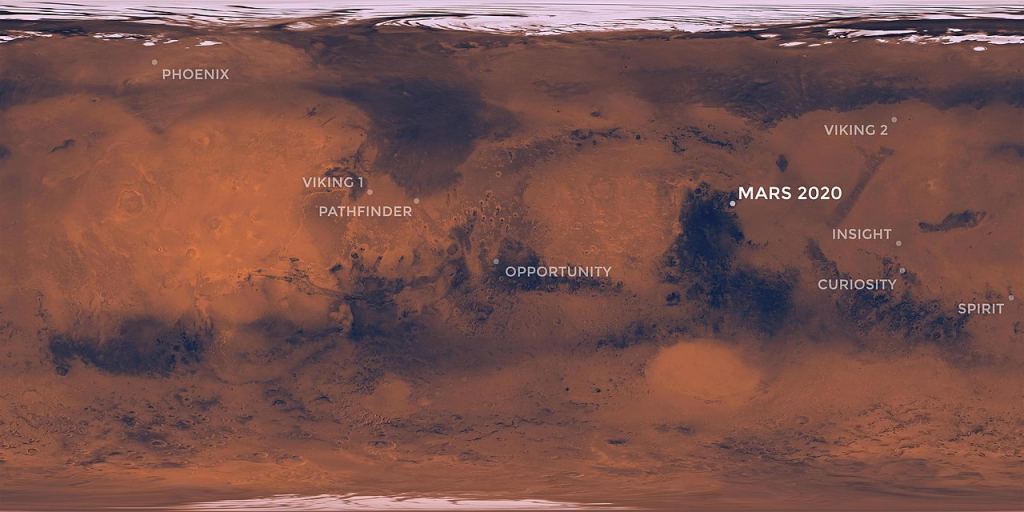Science
Mars 2020 Takes a Test Drive – Universe Today

NASA’s Mars 2020 rover has passed its driving test. The test was mostly a forward and backward maneuver, with a six-wheeled pirouette thrown in. It’s autonomous navigation system was also part of the test. Like a toddler’s first tentative steps, this is an important milestone.
This was a significant test for the rover. According to NASA, the rover passed the test and has earned its driver’s license. The next time it drives will be on the surface of Mars.
“Mars 2020 has earned its driver’s license.”
Rich Rieber, Lead Mobility Systems Engineer, Mars 2020 Rover
“Mars 2020 has earned its driver’s license,” said Rich Rieber, the lead mobility systems engineer for Mars 2020. “The test unambiguously proved that the rover can operate under its own weight and demonstrated many of the autonomous-navigation functions for the first time. This is a major milestone for Mars 2020.”
Though not exactly autonomous, the 2020 rover is designed to make more of its own driving decisions than previous rovers. It has high-resolution, wide field-of-view navigation cameras, part of the group of 23 cameras it’s equipped with. That’s more than any previous rover. The rover has extra computer power that it’ll use to process images and make maps. It also has more sophisticated auto-navigation software.
The 2020 rover will cover a lot of ground during its projected 668 sol (one Martian year) mission to find evidence of past microbial life on Mars. It’ll land at Jezero Crater in February 2021, and to get around on the surface of Mars, it’ll rely on redesigned aluminum wheels, each one with its own motor.
“To fulfill the mission’s ambitious science goals, we need the Mars 2020 rover to cover a lot of ground,” said Katie Stack Morgan, Mars 2020 deputy project scientist.
The 2020 rover is designed to travel about 200 meters (650 ft) every Martian day. To put that into perspective, the record for the longest distance travelled by a rover in one day belongs to NASA’s Opportunity rover. It covered 214 meters (702 ft) in a single day. So 2020’s average day will be about equal to the longest distance ever travelled by a rover in one day.
“We can’t wait to put some red Martian dirt under its wheels.”
John McNamee, Mars 2020 Project Manager.
This latest test took place on Dec. 17th. It was a marathon 10 hour testing session that saw all of the rover’s systems working together. Not only did it drive and steer and turn in place, but it maneuvered over small ramps, to replicate some of the terrain it’ll face on Mars. Since Martian gravity is weaker than Earth’s—only about 3/8ths as strong—NASA expects the rover to perform well once it reaches its destination.
“A rover needs to rove, and Mars 2020 did that yesterday,” said John McNamee, Mars 2020 project manager. “We can’t wait to put some red Martian dirt under its wheels.”
The rover’s wheels are arranged on a pair of legs on each side of the rover, with three wheels per leg. The leg is made out of titanium, one of the lightest and strongest materials available. Each of the aluminum wheels has 48 grousers or cleats on them, which should provide superior traction on Mars’ surface. Each wheel also has its own drive engine, and each of the front and rear wheels also have steering engines, allowing the rover to turn in place.


The wheels also have titanium spokes, which are curved and provide springy support for the 2020 rover. Together, the wheels, legs and engines are called the mobility suspension. The sophisticated system allows the rover to drive over rocks that are about thigh-high on a person, or 1.5 times the wheel diameter. (78 cm; 31 inches)


The 2020 rover will land in the Jezero Crater on Mars. It’s the sight of a long-gone paleo-lake. There’s an abundance of clay minerals there, as well as a fossilized river delta created by an ancient river that flowed into the crater.


The image below shows 2020’s landing spot, as well as the landing locations of other Mars rovers and landers.


NASA’s Jet Propulsion Laboratory (JPL) is building the 2020 rover, and they’ll operate it as well. The 2020 rover is part of a larger program that aims to see humans on Mars. That program includes the Artemis Program, which intends to land humans on the Moon again by 2024, including the first woman on the Moon. NASA also plans to establish a sustained human presence there by 2028, as one of the stepping stones to a crewed mission to Mars.
More:
Science
Giant prehistoric salmon had tusk-like teeth for defence, building nests


|
|
The artwork and publicity materials showcasing a giant salmon that lived five million years ago were ready to go to promote a new exhibit, when the discovery of two fossilized skulls immediately changed what researchers knew about the fish.
Initial fossil discoveries of the 2.7-metre-long salmon in Oregon in the 1970s were incomplete and had led researchers to mistakenly suggest the fish had fang-like teeth.
It was dubbed the “sabre-toothed salmon” and became a kind of mascot for the Museum of Natural and Cultural History at the University of Oregon, says researcher Edward Davis.
But then came discovery of two skulls in 2014.
Davis, a member of the team that found the skulls, says it wasn’t until they got back to the lab that he realized the significance of the discovery that has led to the renaming of the fish in a new, peer-reviewed study.
“There were these two skulls staring at me with sideways teeth,” says Davis, an associate professor in the department of earth sciences at the university.
In that position, the tusk-like teeth could not have been used for biting, he says.
“That was definitely a surprising moment,” says Davis, who serves as director of the Condon Fossil Collection at the university’s Museum of Natural and Cultural History.
“I realized that all of the artwork and all of the publicity materials and bumper stickers and buttons and T-shirts we had just made two months prior, for the new exhibit, were all out of date,” he says with a laugh.
Davis is co-author of the new study in the journal PLOS One, which renames the giant fish the “spike-toothed salmon.”
It says the salmon used the tusk-like spikes for building nests to spawn, and as defence mechanisms against predators and other salmon.
The salmon lived about five million years ago at a time when Earth was transitioning from warmer to relatively cooler conditions, Davis says.
It’s hard to know exactly why the relatives of today’s sockeye went extinct, but Davis says the cooler conditions would have affected the productivity of the Pacific Ocean and the amount of rain feeding rivers that served as their spawning areas.
Another co-author, Brian Sidlauskas, says a fish the size of the spike-toothed salmon must have been targeted by predators such as killer whales or sharks.
“I like to think … it’s almost like a sledgehammer, these salmon swinging their head back and forth in order to fend off things that might want to feast on them,” he says.
Sidlauskas says analysis by the lead author of the paper, Kerin Claeson, found both male and female salmon had the “multi-functional” spike-tooth feature.
“That’s part of our reason for hypothesizing that this tooth is multi-functional … It could easily be for digging out nests,” he says.
“Think about how big the (nest) would have to be for an animal of this size, and then carving it out in what’s probably pretty shallow water; and so having an extra digging tool attached to your head could be really useful.”
Sidlauskas says the giant salmon help researchers understand the boundaries of what’s possible with the evolution of salmon, but they also capture the human imagination and a sense of wonder about what’s possible on Earth.
“I think it helps us value a little more what we do still have, or I hope that it does. That animal is no longer with us, but it is a product of the same biosphere that sustains us.”
This report by The Canadian Press was first published April 24, 2024.
Brenna Owen, The Canadian Press





Science
Giant prehistoric salmon had tusk-like spikes used for defence, building nests: study


|
|
A new paper says a giant salmon that lived five million years ago in the coastal waters of the Pacific Northwest used tusk-like spikes as defense mechanisms and for building nests to spawn.
The initial fossil discoveries of the 2.7-metre-long salmon in Oregon in the 1970s were incomplete and led researchers to suggest the fish had fang-like teeth.
The now-extinct fish was dubbed the “saber-tooth salmon,” but the study published in the peer-reviewed journal PLOS One today renames it the “spike-toothed salmon” and says both males and females possessed the “multifunctional” feature.
Study co-author Edward Davis says the revelation about the tusk-like teeth came after the discovery of fossilized skulls at a site in Oregon in 2014.
Davis, an associate professor in the department of earth sciences at the University of Oregon, says he was surprised to see the skulls had “sideways teeth.”
Contrary to the belief since the 1970s, he says the teeth couldn’t have been used for any kind of biting.
“That was definitely a surprising moment,” Davis says of the fossil discovery in 2014. “I realized that all of the artwork and all of the publicity materials … we had just made two months prior, for the new exhibit, were all out of date.”





Science
SpaceX sends 23 Starlink satellites into low-Earth orbit


|
|
April 23 (UPI) — SpaceX launched 23 Starlink satellites into low-Earth orbit Tuesday evening from Space Launch Complex 40 at Cape Canaveral Space Force Station in Florida.
Liftoff occurred at 6:17 EDT with a SpaceX Falcon 9 rocket sending the payload of 23 Starlink satellites into orbit.
The Falcon 9 rocket’s first-stage booster landed on an autonomous drone ship in the Atlantic Ocean after separating from the rocket’s second stage and its payload.
The entire mission was scheduled to take about an hour and 5 minutes to complete from launch to satellite deployment.
The mission was the ninth flight for the first-stage booster that previously completed five Starlink satellite-deployment missions and three other missions.





-



 Health21 hours ago
Health21 hours agoRemnants of bird flu virus found in pasteurized milk, FDA says
-
News17 hours ago
Amid concerns over ‘collateral damage’ Trudeau, Freeland defend capital gains tax change
-
Art21 hours ago
Random: We’re In Awe of Metaphor: ReFantazio’s Box Art
-
Art15 hours ago
The unmissable events taking place during London’s Digital Art Week
-
Tech22 hours ago
Surprise Apple Event Hints at First New iPads in Years
-
Media20 hours ago
Vaughn Palmer: B.C. premier gives social media giants another chance
-
Science20 hours ago
NASA hears from Voyager 1, the most distant spacecraft from Earth, after months of quiet
-



 Politics19 hours ago
Politics19 hours agoHow Michael Cohen and Trump went from friends to foes





